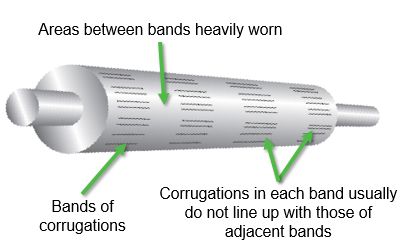Troubleshooting doctors: loading, wear and roll surface marking
Apr 27, 2021
Some doctor problems are rather straight forward, readily recognized, and corrected. However, occasionally one will crop up that seemingly has no solution.
The usual operator solution to these problems is to crank up the blade pressure. This, of course, results in increased maintenance due to worn rolls and blades as well as increased drive loads.
Many doctoring problems are the result of load means not being transmitted to the blade. Some possible causes:
Regular doctors (externally loaded)
- air cylinder(s) bottom out
- bearing hang up
- interference
- loose load arms
- blown air cylinders or airides
- disconnected or failed air hoses
- failed linkage
DST doctors
- debris in-holder
- leaking load tube
- failed air hose
- failed finger rivets
- tubes that have extended in use
- failed or loose pivot brackets
Usually a persistent doctor problem is due to a combination of things. It may not be a problem with the doctor at all, only manifested in doctoring. In tackling such a job, one should learn to “read” blade wear and roll surface conditions.
Blade wear
Always inspect your worn blades, they will give you valuable indications of any doctoring problems. The table below shows some typical wear patterns and probable causes.
| Wear type | Cause | Remedy |
Uneven wear
|
|
|
Center wear
|
|
|
Bow wear pattern
|
|
|
One end wear
|
|
|
Rough blade edge
|
|
|
Wear within trim
|
|
|
Wear outside trim
|
|
|
Localized pitting
|
Blade attacked by:
|
|
Horns both ends
|
|
|
Score on blade edge
|
|
|
Feathered blade edge
|
|
|
Bird's mouth
|
|
|
Roll surface
Roll surface conditions can also tell a lot about doctoring. Some of these conditions can be characterized. The attached charts classify some roll surface conditions as they relate to doctors. They also show roll surface patterns and some possible causes.
Circumferential bands

| Pattern | Causes |
| Ends symmetrically different from center |
|
Cross machine "chops"

| Pattern | Causes |
|
Local (short) cross machine chops center |
Blade vibration due to:
|
Circumferential bands

| Pattern | Causes |
| Local. |
High local wear or scouring:
|
| Roll not doctoring consistently, change in position (guide rolls, etc.) |
|
Cross machine "chops"

| Pattern | Causes |
| Full cross machine chatter all the way around |
Doctor back vibration:
Doctor blade vibration:
|
| Full cross machine at certain spot(s) on roll circumference |
|
Granite roll problems
A common problem with doctoring granite rolls with DST or Equalizer doctors is that a series of corrugated bands may appear on the roll surface. This problem can occur regardless of the granite source, machine builder, doctor supplier, or doctor design. The problem is very random; with two identical machines, one may experience the problem while the other machine will have no problem. The only common element in all cases of corrugation is the use of a DST or Equalizer type doctor.

Typical granite roll corrugations
CD corrugations

| Pattern | Causes |
| Varying intensity and frequency. Generally, worse at machine centerline. |
|
CD corrugations

| Pattern | Causes |
| Local |
|
For more assistance with doctor related problems, download our white papers in the Related Links section and contact your Valmet representative.











